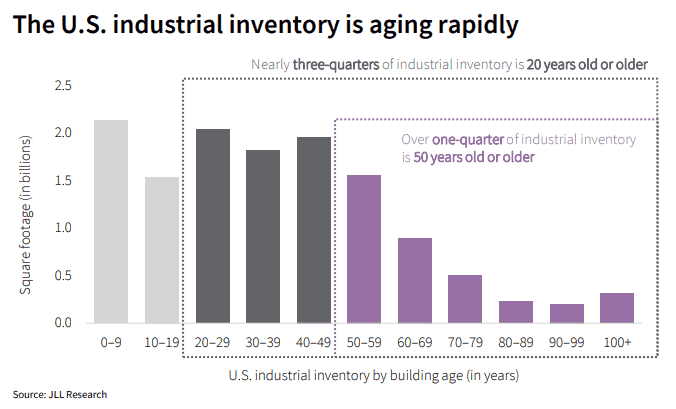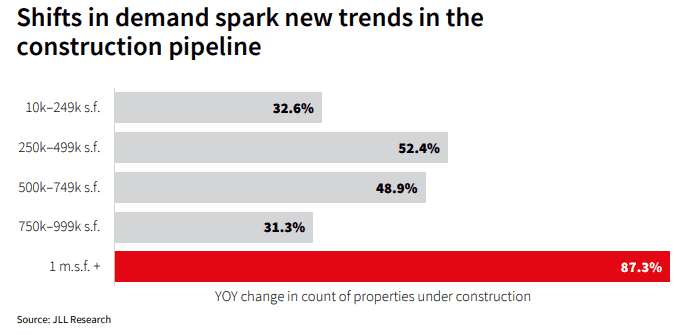A supply crisis is coming soon in the market for US distribution center space, as new construction can’t keep up with demand, and the profile of US sites really starts to age.
Supply Chain Digest Says... |
|
|
That is the conclusion of new research from the real estate team at JLL, released last week.
“There isn’t a lot of availability in the industrial market, and many tenants are being forced to expand or relocate to secondary and tertiary markets with vacancies at the lowest on record,” JLL notes.
Over the last decade, total US industrial inventory increased by 18%, with markets such as Chicago, Inland Empire, Dallas–Fort Worth and Eastern and Central Pennsylvania seeing the most growth. But that overall growth was outpaced by the 24% rise in demand for industrial (mostly warehouse) space over the same period.
As a result, “Given the heightened demand experienced in 2020 and 2021 and the velocity at which it is going forward, we are starting to see the first wave of a supply crunch,” JLL warns shippers.
Some perhaps somewhat surprising data in report comes in the form of the age profile of US warehouse space. As seen in the graphic below from the report, over one-quarter of US industrial inventory is at least 50 years old, and nearly three-quarters of industrial inventory is 20 years or older, with an overall average of around 42 years old.
The import of those warehouse demographics: older buildings typically have lower ceiling heights, fewer dock doors, limited trailer parking and larger footprints, impacting operational efficiency – and just as importantly fulfillment speed.
“With same-day and next-day delivery becoming an important strategy, some companies are willing to pay just about anything to provide this service to key customer bases,” JLL observes, adding that “Demand for Class A space is at its peak, with almost 70% of the newly modernized inventory already preleased upon delivery.”

As a result, lease rates have naturally jumped, up 37% on average across the US from 2016 to 2021, up to $7.11 per square foot, but of course much higher than that in some markets.
(See More Below)
|
CATEGORY SPONSOR: SOFTEON |
|
|
| |
|
|
Interestingly and importantly, JLL notes that warehouse leases are a small part of the overall operating cost formula for shippers, well below transportation and labor costs. However, as rents continue to increase, shipper are seeing this lease expense grow notably and become an important factor when making executive decisions.
JLL says that since shippers want to be near high density urban markets to quickly deliver orders, small-box developments have recently been the most popular size segment to build. This size segment currently accounts for 60% of projects currently under construction.
However, JLL says, while small-box properties account for the majority of the pipeline, developers have faced economic, physical and political dynamic challenges in densely populated areas. As a result, in the last 18 months, the number of mega-box developments being added to the construction pipeline has outpaced all other size segments, as shown in the graphic below:

In another bad sign for shippers, JLL also says the total cost to build a new warehouse, including labor, is up a steep 21% over the last year.
In the report summary, JLL says that still higher rent growth and record low vacancies are on the horizon, leading to DC lease rates that will increase by more than 8% across the entire base in 2022 and could be accelerated by year-end.
It adds that “The imbalance of supply and demand will continue through 2023 and further exacerbate the race for space.”
Given the supply crunch, JLL predicts more recycling of older industrial assets.
“With many older buildings becoming functionally obsolete, over the next decade, these buildings will be torn down, recycled or rebuilt to be more efficient,” JLL adds.
The full report is available here.
Do you expect a warehouse supply crisis? Let us know your thoughts at the Feedback button below (email) or in the Feedback section.
|